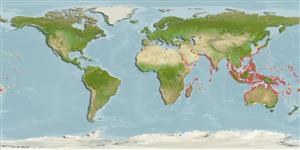Environment: milieu / climate zone / depth range / distribution range
Ecologia
marinhas; estuarina associadas(os) a recifes; não migratória; intervalo de profundidade 0 - 6 m (Ref. 86942). Subtropical; 35°N - 36°S, 18°E - 159°W
Indo-West Pacific: Red Sea and East Africa to Samoa, north to the Ryukyu Islands, south to northern Australia and New Caledonia. Migrated to the eastern part of the Mediterranean Sea via the Suez Canal.
Comprimento de primeira maturação / Tamanho / Peso / Idade
Maturity: Lm 23.1, range 18 - ? cm
Max length : 45.0 cm TL macho/indeterminado; (Ref. 30573); common length : 30.0 cm TL macho/indeterminado; (Ref. 5450); idade máx. registrada: 4 anos (Ref. 126539)
Espinhos dorsais (total) : 0; Raios dorsais (total) : 12 - 15; Espinhos anais: 0; Raios anais : 10 - 12. Greatly prolonged, beak-like lower jaw; upper jaw short, triangular and without scales; preorbital ridge absent; total number of gill rakers on first gill arch 25-36; pectoral fins short, not reaching past nasal pit when folded forward; with 3-9 (usually 4-6) vertical bars on the sides. (Ref. 9843). Color bluish dorsally, silvery on sides. 36-41 predorsal scales. Lower lobe of caudal fin longer than upper lobe. Dorsal and anal fins located posteriorly.
Occur in coastal waters of high islands and continental shorelines; generally in areas rich in vegetation (Ref. 5213) and sand flats (Ref. 48635). Form schools. Adults feed mainly on seagrasses, to a lesser extent on green algae and diatoms (Ref. 9843). Breed in estuaries (Ref. 4164). Marketed fresh and dried salted (Ref. 5284, 9843); meat tasty (Ref. 637). Also caught with dragnets (Ref. 30573) and dipnets.
Ciclo de vida ou comportamento de acasalamento
Maturidade | Reprodução | Desova | Ovos | Fecundidade | Larvas
Collette, B.B. and J. Su, 1986. The halfbeaks (Pisces, Beloniformes, Hemiramphidae) of the Far East. Proc. Acad. Nat. Sci. Philadelphia 138(1):250-301. (Ref. 10943)
Status na Lista Vermelha da UICN (Ref. 130435: Version 2024-1)
Ameaça para os humanos
Harmless
Uso pelos humanos
Pescarias: espécies comerciais; peixe esportivo: sim; isca: occasionally
Ferramentas
Relatórios especiais
Baixar XML
Fontes da internet
Estimates based on models
Preferred temperature (Ref.
123201): 24.7 - 29.3, mean 28.5 °C (based on 3383 cells).
Índice de diversidade filogenética (Ref.
82804): PD
50 = 0.5005 [Uniqueness, from 0.5 = low to 2.0 = high].
Bayesian length-weight: a=0.00380 (0.00290 - 0.00498), b=3.07 (3.01 - 3.13), in cm total length, based on LWR estimates for this species (Ref.
93245).
Nível Trófico (Ref.
69278): 2.7 ±0.30 se; based on food items.
Resiliência (Ref.
120179): Elevada, tempo mínimo de duplicação da população menor que 15 meses (Preliminary K or Fecundity.).
Fishing Vulnerability (Ref.
59153): Low to moderate vulnerability (35 of 100).
Nutrients (Ref.
124155): Calcium = 61.2 [21.4, 168.3] mg/100g; Iron = 0.643 [0.265, 1.468] mg/100g; Protein = 18.8 [16.1, 21.2] %; Omega3 = 0.165 [0.067, 0.461] g/100g; Selenium = 12.5 [4.9, 32.5] μg/100g; VitaminA = 39.7 [9.5, 186.7] μg/100g; Zinc = 1.06 [0.61, 1.80] mg/100g (wet weight); based on
nutrient studies.
